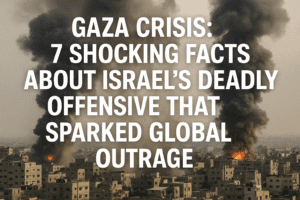Gaza Crisis: 7 Shocking Facts About Israel’s Deadly Offensive That Sparked Global Outrage
Israel’s intensified military offensive in Gaza, dubbed “Operation Gideon’s Chariots,” has plunged the region into deeper humanitarian catastrophe, with over 260 Palestinians killed and 675 injured in recent days. The UN condemns the siege as “beyond inhumane,” citing widespread starvation, collapsing hospitals, and mass displacement as Israel tightens its blockade, severing access to food, medicine, and aid for 2 million civilians.
Ceasefire talks in Doha remain stalled amid Israeli demands for Hamas’ dismantling and hostage releases, while global leaders, including Arab states at the Baghdad Summit, demand an immediate end to hostilities and reject forced displacement as “ethnic cleansing.” Over 53,000 Palestinians—mostly women and children—have died since the war began, triggered by Hamas’ 2023 attack that killed 1,200 Israelis. U.S.-backed aid initiatives face skepticism as infrastructure crumbles, famine looms, and families flee with “only the clothes on their backs.” With the UN warning of systematic collapse and global outcry mounting, the conflict risks spiraling into broader regional instability, leaving civilians trapped in a cycle of devastation with no clear path to resolution.

Gaza Crisis: 7 Shocking Facts About Israel’s Deadly Offensive That Sparked Global Outrage
As Israel intensifies its military campaign in Gaza under “Operation Gideon’s Chariots,” the humanitarian toll on Palestinians has reached catastrophic levels, drawing sharp rebukes from international bodies and aid organizations. With over 260 killed and 675 injured in recent days, the UN warns of a “systematic collapse” of civilian life, while stalled ceasefire talks and geopolitical tensions complicate efforts to end the violence.
Escalating Violence and Civilian Suffering
The Israeli Defense Forces (IDF) describe the offensive as a strategic push to dismantle Hamas and secure hostage releases. However, eyewitness accounts and aid workers paint a dire picture of chaos. Hospitals, like Beit Lahiya’s Indonesian Hospital, report critical infrastructure failures as explosions disrupt power supplies, leaving patients on life support in peril. Displaced families, already enduring months of displacement, face renewed exodus, with transportation costs surging and food prices skyrocketing under siege conditions.
UN Secretary-General António Guterres condemned the blockade as a violation of international law, stating, “Starvation as a tactic of war is unconscionable.” Over 436,000 Palestinians have fled since March, joining nearly 2 million already trapped in what the UN calls a “high-risk” famine zone. A recent UN study reveals 1 in 5 Gazans now face starvation, with children suffering acute malnutrition at unprecedented rates.
Geopolitical Strains and Ceasefire Efforts
The offensive unfolds amid strained U.S.-Israel relations. While President Donald Trump’s administration brokers deals with regional actors like the Houthis, his rhetoric—including calls to turn Gaza into a “freedom zone”—has drawn skepticism. Critics argue U.S.-backed initiatives, such as the Gaza Humanitarian Foundation, lack transparency and risk sidelining established UN agencies. Meanwhile, Arab leaders at the Baghdad Summit demanded an immediate ceasefire, rejecting forced displacement as “ethnic cleansing.”
Ceasefire talks in Doha remain deadlocked. Israeli Prime Minister Benjamin Netanyahu insists on “total victory,” while Hamas demands an end to the blockade. The political impasse leaves civilians caught in the crossfire, with neither side showing signs of compromise.
Historical Context and Humanitarian Fallout
The conflict traces back to Hamas’ October 2023 attack on Israel, which killed 1,200 and triggered the ongoing war. Critics accuse Israel of disproportionate retaliation, citing over 53,000 Palestinian deaths—mostly women and children—since hostilities began. The blockade, now in its 11th week, has crippled Gaza’s healthcare system, with shortages of antibiotics, anesthesia, and clean water fueling preventable deaths.
Aid workers describe a “psychological breaking point” among survivors. “People are fleeing with only their clothes, clinging to scraps of dignity,” says Nael Rahmi, a displaced Gazan. Meanwhile, Israel’s expansion into northern Gaza has left neighborhoods uninhabitable, raising fears of permanent displacement.
The Path Forward
International pressure mounts for a sustainable resolution. The UN and EU urge adherence to international law, while regional players like Egypt and Qatar push for mediated talks. However, Netanyahu’s government remains focused on military objectives, dismissing calls for de-escalation.
Experts warn that without urgent aid access and political dialogue, Gaza’s crisis could spiral into a regional conflict. “This isn’t just a war—it’s a failure of humanity,” says Jan Egeland of the Norwegian Refugee Council. “The world must act before Gaza becomes synonymous with moral bankruptcy.”
As global leaders debate solutions, Gaza’s civilians endure a nightmare with no end in sight. The question remains: Will geopolitical posturing override the imperative to save lives? For millions, the answer may mean the difference between survival and annihilation.
You must be logged in to post a comment.